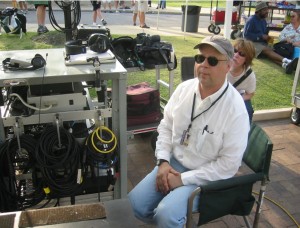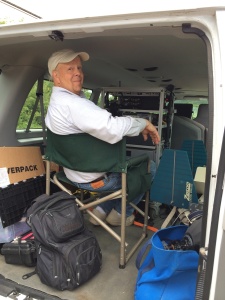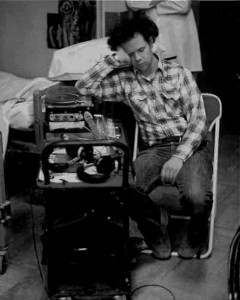Meet the Crew: Jeff Wexler – Production Sound Mixer
Jeff Wexler has been working in the film industry since he was an intern on Harold and Maude back in 1971. His career spans more than four decades with such varied films as Foul Play, Being There, The Natural, Spaceballs, Independence Day, Fight Club and Mission Impossible III. We spoke on location working on his sixth film with Cameron, Aloha.
Looking back on your 40 year career in the film industry, I read that you had no plans to follow in your dad’s footsteps (preeminent cinematographer Haskell Wexler). Tell us how working a summer job on Hal Ashby’s Harold and Maude changed your life?
I had been on sets with my father probably since about the age of two. I was very familiar with what goes on when making a movie but when I started to think about what I would do “when I grow up” it never crossed my mind that I would work on movies. I spent 5 years in college preparing to teach sociology at the college level. One summer I think my father felt that I had been in school long enough and needed a summer job. Of course he got me a job on a movie, working as a production assistant in the Art Department on Harold and Maude. I had known Hal Ashby from times spent going to dailies with my father, visiting the editing room (Hal was an Academy Award winning editor on several movies my father had shot), so I was quite comfortable on the set again, with people I knew. What I was not prepared for was how I felt, for the first time, being on a movie, not as a visitor but as a participant. I fell in love with the movies. When the movie wrapped I made the decision: teaching was out — I would pursue a career working on movies.
Describe to our readers the duties of a Sound Mixer?
I am a Production Sound Mixer and it is the responsibility, with my crew, for all the sound that is recorded during production. This is primarily dialog recording, but we also record sound effects, ambiences, music (sometimes live performances depending on the movie). Many others will work on the soundtrack for a movie in post production (i.e. sound designer, sound editorial, foley, music composer, re-recording mixer, etc.) but the production sound recordings are the primary and fundamental basis for the movie.
There is a widespread mis-conception that the sound in movies is all done later in the comfort of the studio — I have had people come to me on the set and ask what I am doing, “are your recording all of this so they know what the actors are saying.? Nothing could be further from the truth. The value of the production recording, an actor’s performance on the day, in the moment, should never be underestimated. I consider it my highest priority to preserve that performance, that authenticity, on the day of shooting. It is true that production dialog can be replaced later, actors can be brought into a studio to record the dialog months after their performance on the set, but there is always something wonderful that is lost when ADR (automated dialog replacement) has to be done.
Jerry Maguire was your first collaboration with Cameron. How did you get involved with the project?
I don’t remember exactly how I got the call for Jerry Maguire. I had been recommended to Cameron to work on Singles, but a scheduling conflict prevented me from getting on that movie. It may well be that Cameron remembered that meeting and decided to give me a call for Jerry Maguire. However it happened, I am so fortunate to have been asked to work on what I feel is one of Cameron’s best movies. How could I have known that working with Cameron would be a major high in my career, continuing to this day on our latest adventure on Aloha. I am very sure I would not still have this love for making movies were it not for the movies I have done with Cameron, and of course Hal Ashby before.
You came back and worked with Cameron on Almost Famous. That movie is a love letter to music and filled with wall to wall sound. What challenges did you have on that film?
Almost Famous is my all time favorite movie, the experience of working on it, the music, the period in history and the final movie — it doesn’t get any better than that. There really weren’t any special challenges beyond the one challenge that is always in place on a Cameron Crowe movie. I am referring to Cameron’s directing style that makes extensive use of music on the set while shooting. While most directors will go to an actor and explain, in words, the emotion of a scene, Cameron will instead often play music on the set. This is not necessarily the music that will be in the movie, usually it is not, and it goes way beyond what many directors do, playing music to set the mood.
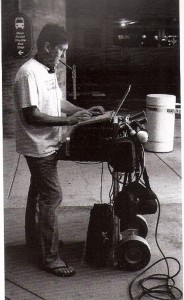
Cameron readies some music on set. The Music Cart was designed and built by Jeff. Picture courtesy of Neal Preston.
One of the things that I think brought Cameron and me together is the fundamental and primary belief in the power of music — this is why I understood so well his use of music on the set. We always make the effort to ensure that dialog is still recorded free of the music and for the most part we have been able to preserve the wonderful performances from our actors that this technique produces. Often it is far more effective to play a Joni Mitchell song for Penny Lane (Kate Hudson) or The Who for Jerry Maguire (Tom Cruise) than to describe in words the feeling or energy for a scene.
Was it especially gratifying to win a BAFTA for Almost Famous?
I think that Almost Famous has one of the best soundtracks ever done and it certainly would have been enough for me to have contributed to so much of that. To get the nomination and win the BAFTA for that movie just made the whole experience one of the best in my career.
Vanilla Sky was a complicated shoot with much of it shot on location in New York. Do exterior locations provide more of a challenge for you and your job?
Location recording, particularly exteriors, is always more challenging than working on a nice soundstage in Hollywood. The world is getting noisier and New York, of course, is no exception. Increasingly, movies are being made on location in conditions that can have catastrophic consequences for the production sound. We did okay on Vanilla Sky even in New York, because the budget was sufficient to have the all-important control over locations where we shot.
We always hear such good things about working with Tom Cruise. You’ve worked with him on Jerry Maguire, Vanilla Sky, The Last Samurai and Mission Impossible 3. Tell us a Tom story….
I loved working with Tom. He is about as knowledgeable of the movie-making craft as any actor I have worked with. So many actors just do their thing and expect that everyone else will somehow capture it all, oblivious to the fact that making movies is a highly technical endeavor. Tom has that incredible balance between acting, an authentic performance, and accommodating the demands of the technical medium we work in. Simple things like letting the camera operator know how quickly you are going to be getting up from a chair, letting me know that he is going to be screaming a line of dialog on the next take.
Tom also understands editing — things we have to do on the set that often feel very artificial and un-natural, allow for the editorial process to produce a scene that feels real and authentic. Tom is very demanding of the people he works with but this is NOT what all those stories say about how you’re not supposed to look at Tom, not supposed to speak to him — this is nonsense and a total fiction. What Tom demands is that every crew member give 100% to the movie, just as he does everyday on the set.
Was your 2011 CAS (Cinema Audio Society) Career Achievement Award the highlight of your career so far?
The CAS Award was actually quite a surprise. I am a big supporter of CAS (I’ve been on the Board of Directors for several terms) and I have always liked the fact that we call it the Career Achievement Award rather than the Lifetime Achievement Award that other organizations award. Although I have done quite a few really good movies, my overall resume pales in comparison to many others, but what I learned about the CAS Award is that it really is about an individual’s contribution to our craft, to our industry, not just the list of movies we have done. The CAS Award night always honors a Filmmaker along with the Career Achievement Award for Sound. I wanted Cameron to be honored for that Award but he was not able to make it.
What’s it been like working in Hawaii on Cameron’s latest film, Aloha?
We always think of working in Hawaii as this beautiful, quiet and serene place, with wonderful natural sounds of nature and so forth, but on Aloha this was not the case. Honolulu is a very noisy place and home to Hickam Field where we did most of our shooting. As good as our Location Manager is — and I love John Panzarella, he’s the best — there is no way to stop flight training F-22 flyovers. The only good thing about those planes is that they are very, very fast, so the incredible sound they make was not with us on the set for very long.
We did have to stop shooting for certain periods but for the most part I think we did okay getting decent dialog. We did have a few scenes that took place in locations that were breathtakingly beautiful, and quiet — those days were a welcome relief from the endless noise at Hickam. Early in pre-production Cameron was telling me about the challenges for the sound, but he kept repeating that we should “embrace” the reality and not let it bring us down. I did have some difficulty with this idea of embracing an ongoing assault on the soundtrack, but I had no problem embracing the chance to work with Cameron again on what I knew would be an amazing movie.
You mentioned earlier that Cameron likes to play music on set right before a take or during a take to help set the mood for the actors. Does that help or hinder you in any particular way?
We’ve pretty much got it down so that playing music, even during dialog scenes, isn’t really a problem. The thing that is different on every movie is how the actors respond to this unique directing technique. I have observed that there are times when the music is a distraction, actually, and possibly helps Cameron more than it does the actor. In terms of its impact on the soundtrack, it certainly does create more work for sound editorial in post but Cameron often has a lot of the same people in post working on the movies so they are used to it. Because playing the music pretty much wipes out the chances of getting clean, live ambiences and effects (the stuff that happens when the actors are not speaking), all the backgrounds have to be created later and there will be a lot more Foley work needed.
Any plans to slow down or is your job still as rewarding and challenging as ever?
Things have been slowing down sort of naturally for me and I have not been seeking out movie work just for the sake of employment. The challenges and the rewards are still there when I work on movies with the people I have a history with, a mutual respect and understanding, and I will always be up for working with Cameron for as long as he wants me on the movies.
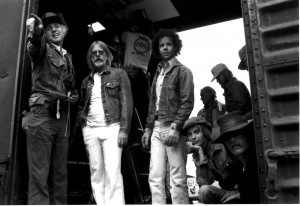
1976 -(Left to Right) Haskell Wexler, Hal Ashby & Jeff on the set of Bound For Glory. Picture courtesy of Jeff Wexler.
I bet Cameron is always picking your brain for stories about you working with director Hal Ashby on films such as Harold and Maude, Bound for Glory and Being There. Tell us your favorite Ashby story.
Well, one of the stories that Cameron likes to hear comes from my very first job with Hal on Harold and Maude. I was hired to work in the Art Department but Hal already knew that I had a love for music and I was sort of a sound geek (though I hadn’t done any real sound recording yet). I went to Dailies every day (Dailies being the projected film from the previous day’s shoot) and this was back when on location there was a screening room set up, often in the office or the hotel, where you would view the actual film with sound that had been shipped to location from the Editing room in Los Angeles. The projectionist had worked with Hal many times, Billy Braser, but this time his projector was having really bad sound problems. Knowing that I had some really good Hi-Fi equipment at home, Hal asked if I could bring anything in to our screening room to improve the sound.
I did in fact bring in a better amplifier and speaker, hooked it up to Billy’s projector, and this was a huge improvement in the sound. The other thing Hal asked for was for music in the screening room. Hal did not play music on the set but he hated watching MOS footage (footage that had been shot without sound, where there was no dialog). Normally, Editorial would put some music with the MOS footage but the turnaround with the film going to L.A. to be processed, synced up and sent back to us in Northern California, the Assistant Editor had no time to do this. Hal had been thinking about Cat Stevens music so I brought my Singer portable record player into the location screening room. When the silent footage came up with Harold driving his hearse on the highway in the rain, I put the needle down on “Trouble”. I think it was at that very moment we knew that Cat Stevens would be part of the heart and soul of this quirky love story that defined Hal Ashby’s career. You could say that this was my first job in sound and it was all about the music. Hal was one of the first to use songs to score a movie rather than the traditional composer orchestrated scores that were the norm. Twenty-five years later I found myself working with Cameron who embraced the undeniable power of music in filmmaking in so much the same way as Hal Ashby.
Besides Ashby, you’ve worked on more of Cameron’s film that anyone else (6 films so far), what keeps bringing you back?
Cameron is probably the most collaborative director I have ever worked with, right up there with Hal Ashby. Cameron has that rare ability to involve those working on the movie, welcoming their active participation beyond the boundaries of any given craft. When Cameron asks me how I felt a certain scene played, he’s not asking just about the sound. Cameron knows that even though I am hired to record the sound, my commitment is to the movie, the performances, the story, and he expects to hear from me, whether the scene works or not.
© 2015 The Uncool by Vinyl Films. All rights reserved.



